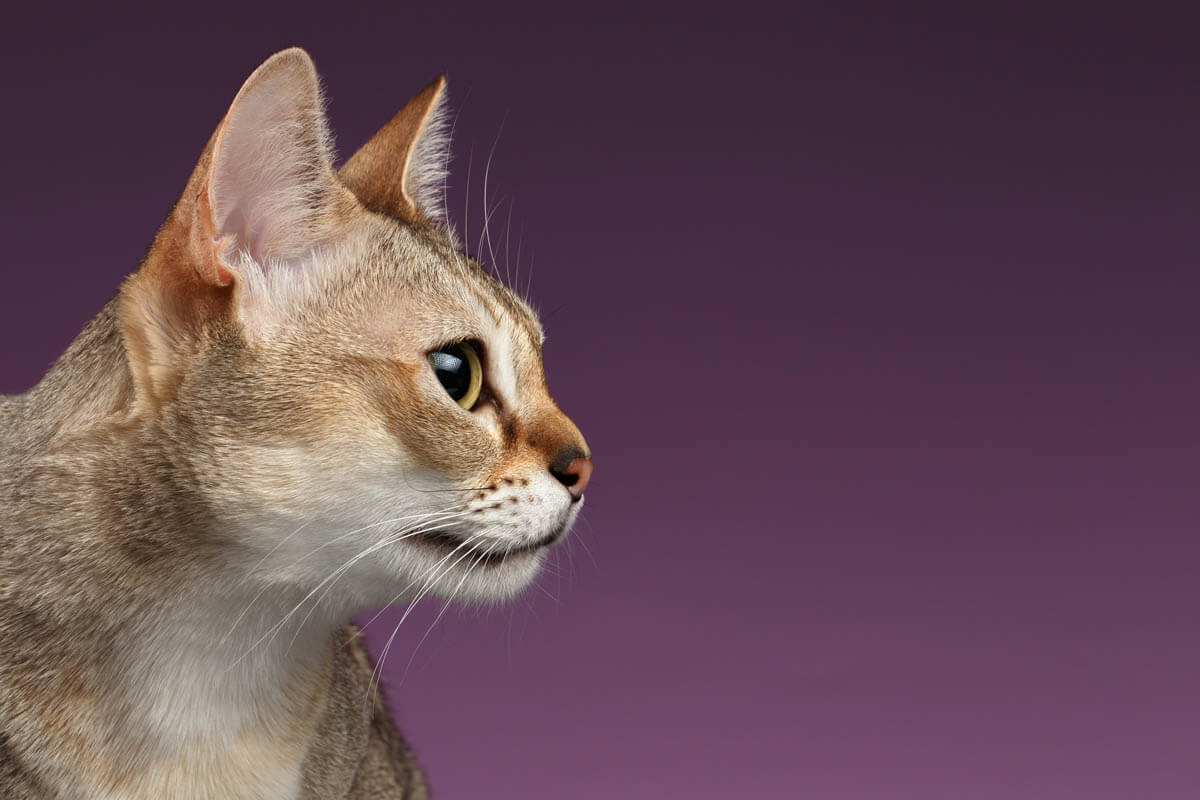At a glance
|
About
The Singapura is the smallest breed of domestic cat which is known for its large eyes and ears and close-lying ticked fur. They are said to have originated from drain cats in Singapore although their history is shrouded with controversy.
Singapuras are enchanting and everybody is won over by their inquisitive, laid-back and friendly personality who is easy to care for and will remain playful well into adulthood.
History
In 1971, Hal Meadow, a geophysicist working in Singapore, noticed three unusual-looking brown-ticked cats. He sent these cats back to his friend Tommy in America aboard a company ship.
Later, a fourth brown ticked cat was sent back to America. These cats were sent without export or import papers — Tommy who had an interest in genetics bred with these ticked cats. Apparently, at the time, she had no interest in starting a new breed and therefore kept no paperwork. Then in 1974 the now married Hal and Tommy was transferred to Singapore, and they brought along five of their cats, two Burmese and three grandchildren of the original cats shipped over from Singapore in 1971. These grandchildren were named Ticle, Tes and Pusse. They declared the Burmese as such to quarantine, not knowing what to declare the other three cats as Tommy declared them to be Abyssinians as they looked like Brown Abyssinians to her.
The Meadows continued to breed with these cats. Ticle and Pusse had two kittens named George and Gladys. These cats were recognised by the Singapura Cat Club provisionally as Singapuras.
Following the fall of Saigon in July 1975, the Meadows returned to America, bringing back Ticle, Tes, Pusse, George and Gladys. They then set about obtaining official recognition for the breed and in 1981 presented the Singapuras to the American CFA as a natural breed, in 1988 they were accepted for championship status with the American CFA.
In 1980, another American cat breeder, visiting an SPCA shelter in Singapore, discovered a cat named Chiko, with the same colouring and ticked coat of the Singapura. Chiko was sent to breeder Barbara Gilbertson in Washington, where she was a great asset to the small gene pool.
Controversy:
There has been some controversy surrounding the breed’s origins. An American Singapura breeder by the name of Gerry Mayes visited Singapore in 1987 to look for street cats fitting this description. He spoke to locals who didn’t know anything about local cats who looked like the Singapura. Mr Mayes returned to America with several cats from Singapore, but he also had some interesting information in regards to the original cats imported by the Meadows in 1974.
The original story told by the Meadows was that they discovered Ticle, Tes and Pus in Singapore in 1974, however, papers indicated that Ticle, Tes and Pus had been brought into Singapore by the Meadows in 1974 as import records showed that the Meadows imported two Burmese and three Abyssinians it was suggested that there was no such local cat in Singapore, but the Singapura was, in fact, a Burmese x Abyssinian hybrid.
Another version is that the discrepancy was discovered when the Singapore Tourist Promotion Board (STPB) decided to adopt the Singapura as a mascot. While performing background checks on the breed, the discrepancies with the paperwork were discovered. The Singapura was locally given the name Kucinta, meaning love cat as a result of this campaign.
Tommy Meadows was asked to explain the discrepancy to the CFA on 9th and 10th February 1990. Tommy explained the reason for the discrepancy was that Hal had been in Singapore in 1971 on a sensitive trip. Records proved that Hal had been in Singapore in 1971. The CFA accepted Tommy’s explanation and the breed are still recognised as a natural breed.
The Singapura in Singapore:
In 1993 the Singapura became the official symbol of Singapore. Two pedigree cats were returned there and acted as models for statues of Kucinta, which are positioned on the Singapore River, where the breed supposedly began its existence. [1]
The purpose of this article isn’t to speculate about the origin of the Singapura, but to tell the story of the breed.
Appearance

The Singapura is a dainty and elegant cat who hasn’t changed over the years. They are small to medium in size, but muscular and are surprisingly heavy when you pick one up. The legs are slender but muscular, leading to small, oval-shaped paws. The tail is slightly shorter than the body, ending with a black, blunt tip. The hind legs are slightly longer than the front legs. Females can weigh from 3.5-4.5 kg and males 4.5-5.5 kg.
The head is round with strikingly large ears and large, expressive eyes which range in colour from hazel to yellow and are surrounded by dark eyeliner. The nose is brick red, with the same dark markings as the eyes.
Cheetah marks (or lines) run from the inner eye to the whisker pads, and the traditional tabby M marks the forehead.

The coat is close-lying, satiny, ticked coat of sepia brown. This means that the individual hairs on the cat have alternating bands of sepia brown and the warm ivory ground colour.
Personality
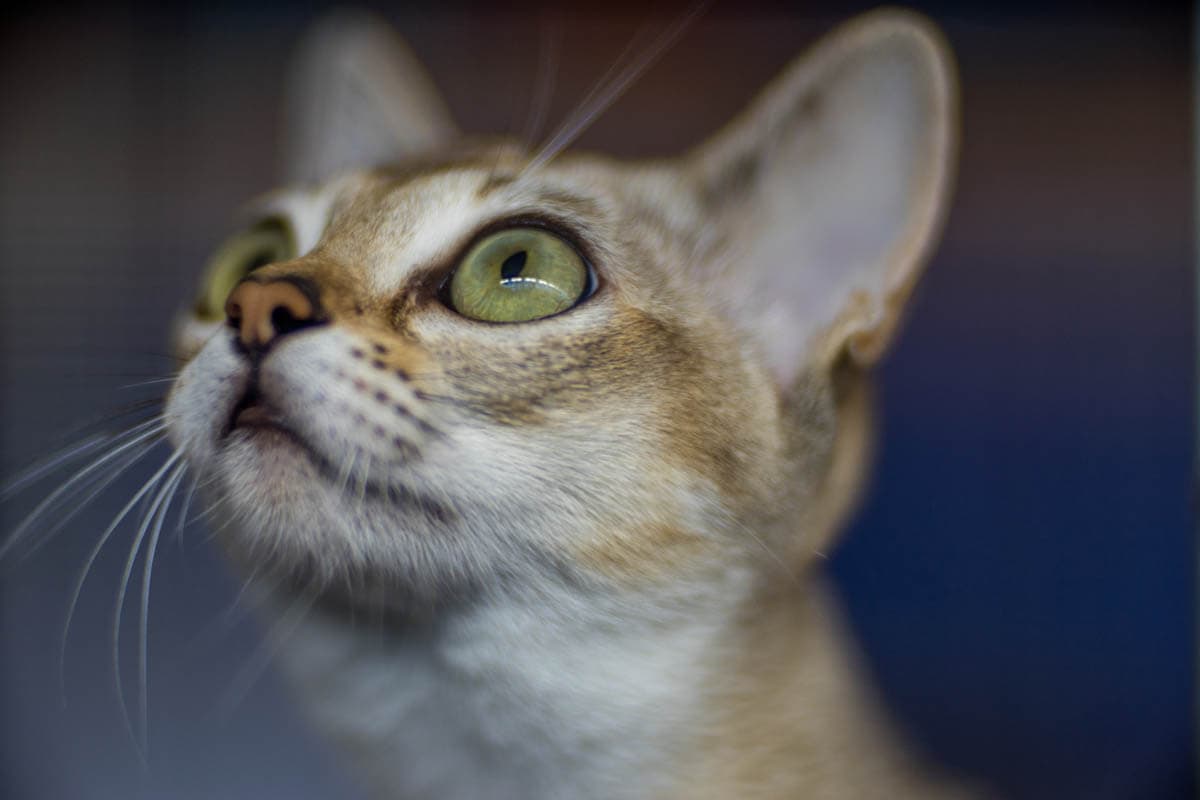
These beautifully proportioned and graceful creatures can charm and take hold of your heart and soul. They have a love of warmth and will often be found under your doona cover, hogging a heater or lying in the sunshine. They love to be up high, laps and shoulders are great as are the tops of cupboards, doors, and fridges. It is also amazing the places they can squeeze their little bodies. I have found one curled up asleep in an empty two-litre ice-cream container and another in the sleeve of a jumper. The only thing better than one Singapura is two or three or…more. Once you have owned a Singapura you’ll never be without one.
Singapuras are cheeky, lively, extremely curious, full of mischief, affectionate, intelligent, inquisitive, fun-loving cats, which actively seek out human company.
They are non-confrontational and will rarely enter into a dispute or quarrel. The females tend to be the more dominant sex while the males are a little easier going.
Litter sizes range from two to four kittens. Singapura cats make wonderful mothers; they often nurse their kittens well past the weaning times of other breeds.
Suitable for
The Singapura is a great family pet; they get along well with children and is an outgoing breed that thrives on companionship.
Care
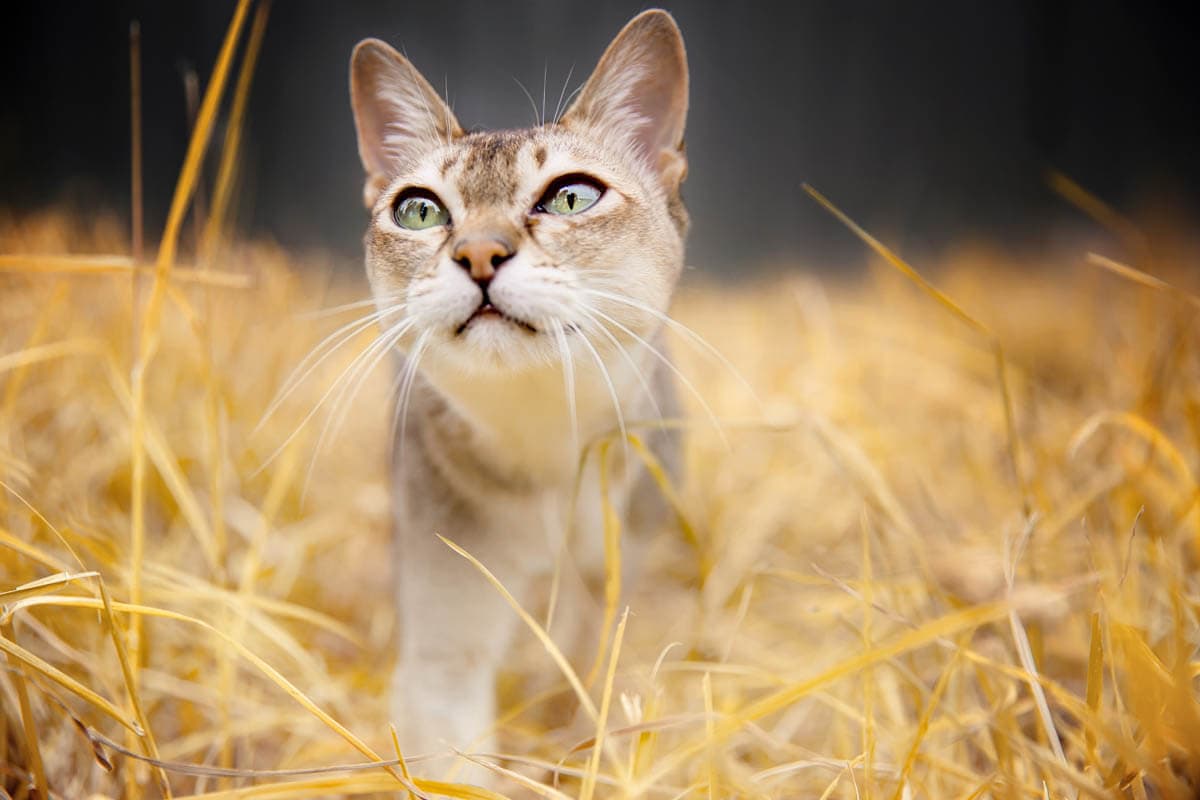
Due to their short, easy-care coat, the coat only requires a weekly groom.
Indoor cats should have their claws trimmed every 4-6 weeks.
Indoor life is best for your Singapura cat. Provide plenty of toys, as well as your attention. Scratching posts for sharpening claws and climbing is a must, the taller, the better.
Dental care is important for all cats. Daily brushing with a pet toothbrush and toothpaste and/or provide your Singapura with raw chicken necks or chunks of beef.
Your Singapura should see a veterinarian once a year for a check-up, increasing to twice a year once your cat reaches seven.
Health
The Singapura is an overall healthy cat, but are at risk of an inherited disease known as pyruvate kinase deficiency which is a form of hemolytic anemia (destruction of red blood cells which occurs faster than they can be produced) caused by a deficiency of pyruvate kinase, an enzyme in red blood cells responsible. When there is a deficiency of pyruvate kinase, red blood cells cannot produce the energy they need to survive and die prematurely. A genetic test is available to determine if cats carry the gene, always ask potential breeders if they screen their cats.
Footnote
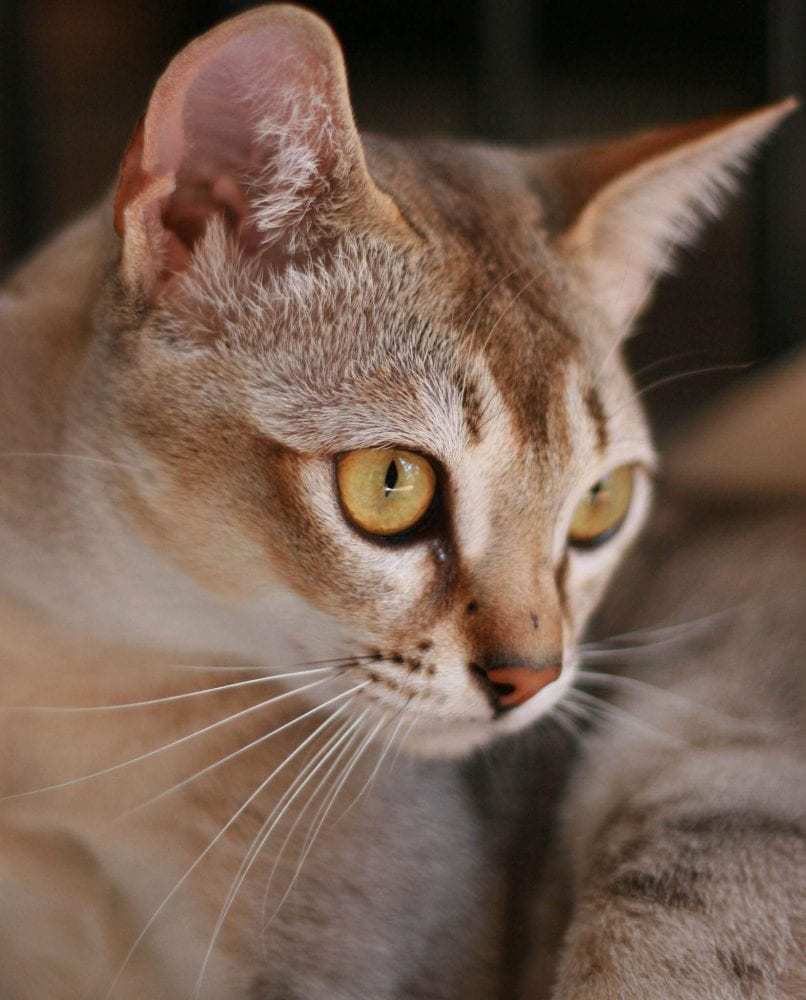
Some of the images in this article are of our Singapura cat, Levi, who sadly passed away in March 2017. Levi grew up in a home with two small children, two dogs and several cats without a problem. Our experience sharing a home with a Singapura is that they are a beautiful natured cat who loves everybody they meet. Thank you to Kim for bringing Levi into our lives.
Frequently asked questions
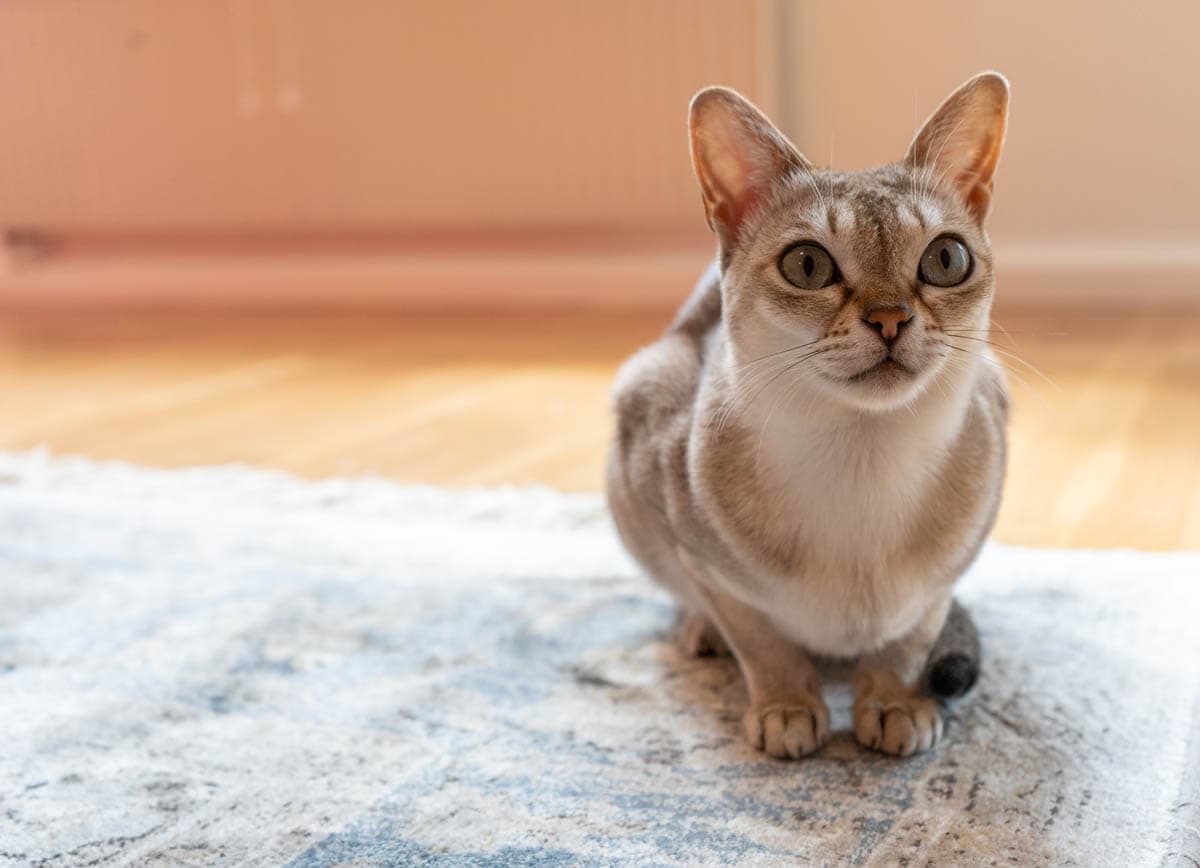
Are Singapura cats rare?
Yes, the Singapura is a relatively rare cat.
How much do Singapura cats cost?
Singapura cats cost between $1,000-$1,500
Do Singapura cats shed?
All cats shed, the Singapura has very little undercoat and close-lying guard hairs, there is less hair in the environment than other cat breeds.
Related: Cat breeds that shed the least
How long do Singapura cats live?
Singapuras live between 10-15 years.
Is my cat a Singapura?
Unless you have purchased the cat from a registered cat breeder, the chances are your cat is not a Singapura. This is a scarce breed of cat, and while not impossible, it is highly unlikely a Singapura would find itself homeless or in a shelter. If one was surrendered to a shelter, it would be immediately snapped up.
A small tabby cat does not equal a Singapura. Cats come in all shapes and sizes, our pedigree Singapura was a strapping 4-5 kg cat, meanwhile, we have a tiny Tonkinese. Size is only one element.
A Singapura has a short, ticked coat, cheetah lines and no tabby markings aside from the face and possibly some banding on the legs. There are no longhaired Singapura cats and the only tabby markings they have are on their face and legs.
If you are still not convinced, the only way to prove a cat is a Singapura is to pay for a DNA test from a reputable provider.
Is there a longhaired Singapura?
No, the Singapura is a shorthaired cat, there is no such thing as a longhaired Singapura.
References:
[1] Desmond Morris, Cat Breeds of the World.
